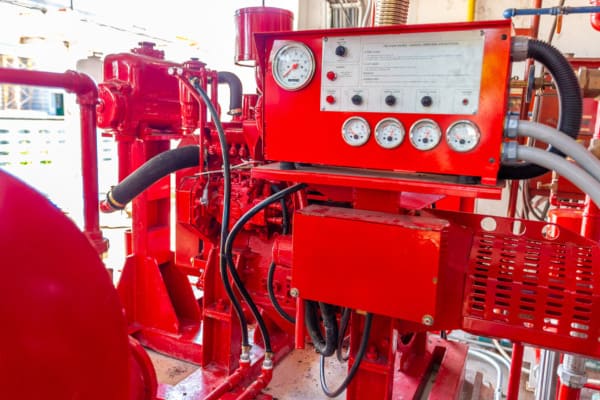Choosing the right fire pumping system is an important part of protecting homes, businesses, and factories from fire. The fire pump is the most important part of a fire safety system because it provides firefighters with the hydraulic power and flow they need to fight fires. Fire pumps come in a variety of sizes, so choosing the right type and configuration requires an in-depth knowledge of your property layout, building codes, and all applicable local regulations. The right choice can mean the difference between successfully controlling a situation or causing major damage. Here are some things you should know before purchasing fire pumping equipment.
How to Understand the Function of a Fire Pumping System
Before purchasing a fire pump, it is important to understand how it works. Fire pumps increase pressure when the main water source does not have enough water supply to meet the needs of the firefighting equipment. This extra pressure ensures that sprinklers, standpipe systems, and hose reels function properly in an emergency. Fire pumps are activated when the system pressure drops, such as when a sprinkler head is turned on or a hose is pulled out. The pump then pumps water from a storage tank, pool, or city water system to the fire protection system with enough hydraulic power to extinguish the fire.
Consider Your Building’s Needs and Risks
Before choosing a fire pumping system, consider the size of your building, its use, and how dangerous it is. Fire safety regulations vary for high-rise buildings, retail stores, workplaces, and hospitals. Taller buildings require more pressure to move water up and down. Warehouses and factories may require a higher water flow rate due to the large amount of flammable materials present. Apartment buildings may require a combination of pressure and flow to operate sprinkler heads quickly. The type and size of fire pump needed is also affected by the level of hazard in the building, such as the presence of burning materials or critical equipment.
Considering Your Water Supply
Which fire pump system is best for your home largely depends on the source of the water in the pump. If your building’s water comes from the city, you’ll want to make sure the flow and volume of water from your main water source are sufficient. In remote areas, your fire pump may need to draw water from a well, storage tank, pond, or lake. This means that the pump must be able to move water over long distances or up and down, which requires choosing the right type of pump. A vertical turbine pump is a type of pump that works well in deep water. Knowing where your water source comes from can help you choose a pump system that will work well in any situation.
Different Types of Fire Pumps
There are many different types of fire pumps, each suited to specific situations. One of the most popular types of pumps is the horizontal split-case pump, which is used in many commercial and industrial settings. They are known for their durability, ability to handle large volumes of water, and ease of maintenance. End suction pumps are smaller and better suited for buildings with limited space. Vertical straight pumps save space and are ideal for medium-sized buildings, especially where floor space is limited. Vertical turbine pumps are suitable for locations where the water source is below the pump, such as an underground well or water tank. Understanding the different types of pumps can help you tailor the system to the physical and functional needs of the home.
Power Sources to Consider
You can power fire pumps with electricity, gasoline engines, or, in rare cases, steam generators. Electric fire pumps are popular in locations where electricity is stable. They are quieter, require less maintenance, and are generally smaller. However, they are dependent on the electrical grid, which can fail during a crisis or fire. For locations that need extra power, diesel pumps are ideal. They are not connected to the electrical grid and can continue to operate even if the power goes out, making them ideal for important buildings or locations that are far from other people. For safety reasons, many locations choose to install two pump sets, one electric and the other gasoline. The power source you choose should be compatible with your building’s energy reliability and emergency response capabilities.
Capacity and Performance Needs
GPM stands for gallons per minute and PSI stands for pounds per square inch. These numbers indicate the capacity of the fire pump. These ratings must meet the requirements, and engineers can help you choose a pump that satisfies these needs without being too strong or too weak.
Connecting the Controller to the System
Every fire pump system is controlled by a fire pump controller. A pressure sensor tells the controller when to start and stop the pump. The National Fire Protection Association (NFPA) states that this device must work with the pump and meet standards. It must also work with the building’s fire alarm system to sound an alarm, send a message, or take other actions to keep people safe in an emergency. Modern controllers have digital displays that record data and can be monitored remotely. These features can help building managers track pump usage and take quick action in the event of a problem or incident.
Access for Testing and Maintenance
When choosing a fire pump system, don’t forget about ease of maintenance. Fire pumps should be checked regularly to ensure they are working properly in an emergency. No-flow tests should be performed weekly or monthly, and full-flow tests should be performed annually. The pump system should be installed in a location that is easy to inspect and troubleshoot. Gauges, test leads, and easily accessible piping should be installed in the system for easy maintenance. Choosing a maintenance-friendly design will help ensure fire code compliance and that the system is ready for use at all times.
Comply with local and national regulations
Fire pump systems must comply with national regulations, such as NFPA 20, as well as local fire and building codes. These regulations cover everything from the type of pump to installation and testing and maintenance. Failure to comply can result in fines, legal issues, or a fire protection system that does not function properly. To avoid potentially costly mistakes, consult with your local fire department, inspectors, and qualified fire protection professionals before selecting and installing your system. Systems that comply with regulations are not only safer, but are also more likely to pass inspections and receive insurance reimbursement.
Cost and Value of a Long-Term Investment
Getting the right value for your money is always important, but choosing the cheapest fire pump system can cost you a lot in the long run. A well-made, high-quality fire pump from a reputable company may cost you more up front, but it will save you money in the long run because it works well, requires less maintenance, and has fewer breakdowns. Additionally, insurance companies generally prefer homes with good fire safety features, which means lower premiums. The right fire pump system can increase long-term value by protecting people, property, and processes in an emergency.
Determine what you need to do to stay safe
Choosing the right fire pump system is important because it is related to the safety of everyone in your building. It is not enough to just choose a set; you also need to understand what your building requires, the regulations in your area, and what you need to do in an emergency. A properly selected and maintained fire pump can mean the difference between minor damage and total destruction. By working with experienced professionals and paying attention to important features such as capacity, power, water supply and system compatibility, you can install a fire pump system that gives you peace of mind and reliable safety when you need it most.

